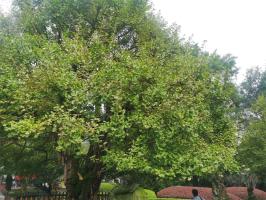Introduction
The threat of climate change is one of the biggest environmental crises facing our world today. The negative impact of human activities on the environment has led to the need for climate control measures to mitigate the effects of climate change. One of the most effective ways to tackle climate change is to plant trees. This article will examine how planting trees can help mitigate the effects of climate change.
Benefit #1 – Carbon Dioxide Absorption
Carbon dioxide is a greenhouse gas that contributes significantly to global warming. Trees absorb carbon dioxide through photosynthesis, which means planting trees can help reduce the amount of carbon dioxide in the atmosphere. One mature tree can absorb up to 48 lbs (21.77 kg) of carbon dioxide per year. By planting more trees, we can reduce the amount of carbon dioxide in our atmosphere and mitigate the effects of climate change.
Benefit #2 – Forests Stabilize the Climate
Forests play an important role in stabilizing the climate. They are a vital component of the carbon cycle, which is the process through which carbon is exchanged between the atmosphere, oceans, and land. When forests are destroyed, they release the carbon they have stored into the atmosphere, contributing to global warming. By planting trees and preserving forests, we can help stabilize the climate and reduce the effects of climate change.
Benefit #3 – Reduced Energy Usage
Planting trees has a direct benefit on energy usage. Trees provide shade and cooling, which can reduce the need for air conditioning during the summer months. This can help reduce energy usage and decrease the amount of greenhouse gases that are released in the process. Planting trees in urban areas can also help reduce the urban heat island effect, which occurs when cities are significantly warmer than surrounding rural areas due to the abundance of concrete and lack of green spaces.
Benefit #4 – Biodiversity Conservation
Trees play a vital role in preserving biodiversity. They provide habitats for a variety of animal and plant species, many of which are essential to our ecosystems. Planting trees can help restore degraded habitats and enhance the natural environment. This can help preserve biodiversity and ensure the sustainable use of our natural resources.
Benefit #5 – Soil Conservation
Planting trees can also help improve soil quality and prevent soil erosion. Trees help to bind the soil together with their roots, reducing soil erosion and keeping the soil in place. They also add organic matter to the soil, helping to improve its fertility and overall health. This can result in improved agricultural production and ensure the sustainable use of our natural resources.
Conclusion
Planting trees is one of the most effective ways to mitigate the effects of climate change. Trees absorb carbon dioxide, stabilize the climate, reduce energy usage, preserve biodiversity, and improve soil quality. Governments, organizations, and individuals should work together to plant more trees and preserve forests to ensure a sustainable future for our planet.

 how many times do yo...
how many times do yo... how many planted tre...
how many planted tre... how many pine trees ...
how many pine trees ... how many pecan trees...
how many pecan trees... how many plants comp...
how many plants comp... how many plants can ...
how many plants can ... how many plants and ...
how many plants and ... how many pepper plan...
how many pepper plan...






























